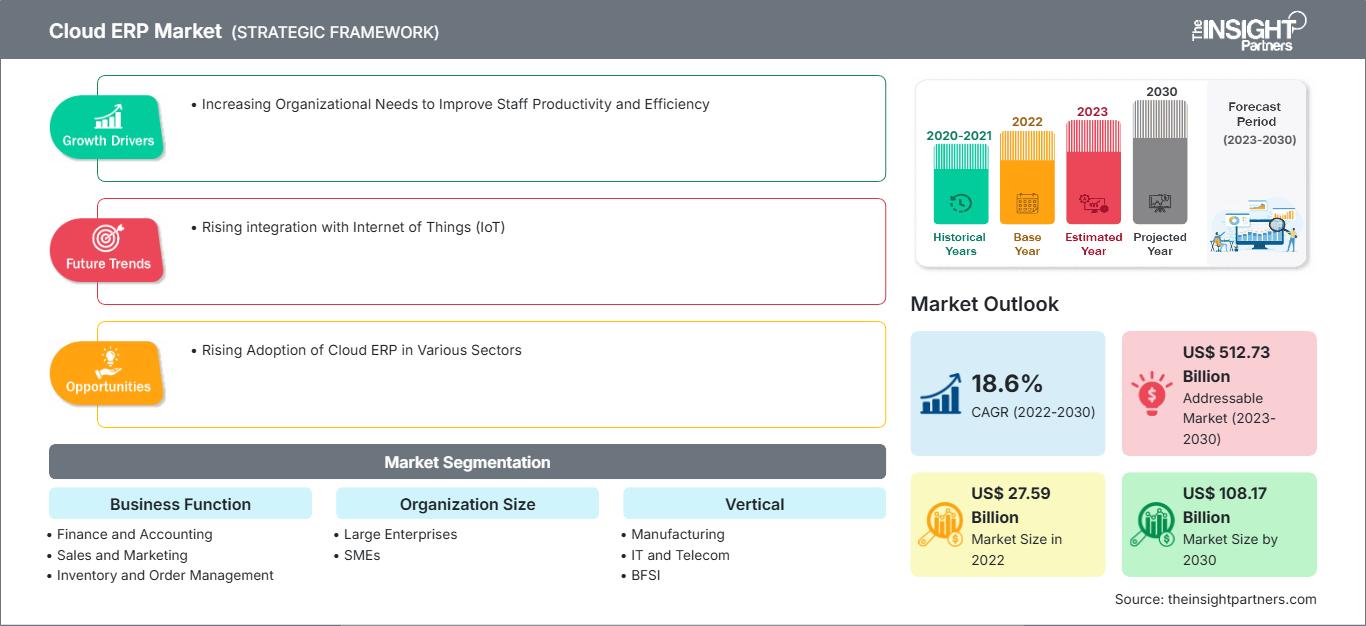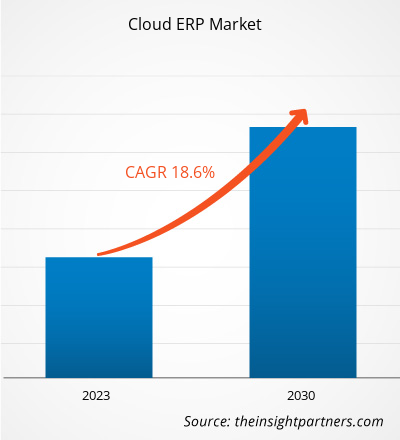预计云 ERP 市场规模将从 2022 年的 275.9 亿美元增长至 2030 年的 1081.7 亿美元;预计 2022 年至 2030 年的复合年增长率将达到 18.6%。与物联网 (IoT) 的日益融合很可能仍将是市场的主要趋势。
云 ERP 市场分析
各家公司正在推出新的基于云的 ERP 软件。例如,2023 年 6 月,10X ERP 宣布推出其基于云的 ERP 软件,该软件专为满足中小型工业分销企业的需求而设计。该解决方案提供直观、用户友好且快速的体验。其核心功能涵盖广泛的特性,包括销售和采购订单输入、库存管理、客户和供应商关系管理、实时仪表板、自定义运输集成器、质量控制管理工具以及提供实时数据的强大、完全集成的会计系统。市场参与者的这些举措正在推动云 ERP 在市场上的增长。此外,制造业、IT 和电信业、BFSI、医疗保健、零售业等各个垂直行业越来越多地采用云 ERP 软件,这也推动了市场的增长。此外,软件技术的不断进步有望进一步推动云 ERP 市场的增长。
云 ERP 市场概览
云 ERP 被称为可通过互联网访问的企业资源规划软件。云 ERP 托管在提供商的云计算平台上,通常以服务形式交付(软件即服务或 SaaS ERP)。云 ERP 软件具有多种优势;云 ERP 软件的最大优势之一是其几乎无限的可定制性。附加解决方案、开放 API、行业特定功能以及基于角色的仪表板,使企业能够部署强大的决策工具、无与伦比的数据可视性以及面向未来的成功平台。企业可以根据其特定行业的需求(例如分销、制造、零售和建筑等)选择合适的版本。现场和办公室团队协同工作,以在预算内按时完成多个项目,但当缺乏有效的信息时,挑战就会随之而来。建筑专用 ERP 软件集成了各种应用程序和系统(包括财务、成本会计、库存、客户关系管理、工资单和项目管理等),从而提供完整、实时的业务视图,并即时连接团队中的所有员工。
自定义此报告以满足您的要求
您将免费获得任何报告的定制,包括本报告的部分内容,或国家级分析、Excel 数据包,以及为初创企业和大学提供超值优惠和折扣
云ERP市场: 战略洞察

-
获取本报告的主要市场趋势。这个免费样本将包括数据分析,从市场趋势到估计和预测。
CloudERP 市场驱动力与机遇
企业日益增长的需求,以提高员工生产力和效率以利于市场发展
在当前快节奏、竞争激烈的商业环境中,企业不断寻求提升产出和效率的方法。基于云的企业资源规划 (ERP) 系统因其有助于业务增长、协作和高效运营而备受关注。与传统的本地部署系统相比,云 ERP 具有诸多优势。只要有互联网连接,即可从任何地点访问基于云的系统。这意味着员工可以检索关键的业务协作数据并远程执行任务。例如,销售代表可以在旅途中访问实时库存数据,从而及时与客户互动。云 ERP 提供实时数据更新和分析,可用于做出明智的决策。例如,利用从云 ERP 系统获取的数据,管理人员可以实时监控库存水平和需求,从而主动补货并优化生产计划。云 ERP 包含协作工具,可改善团队合作和协调。例如,云 ERP 系统可以促进远程团队之间的项目管理和协作,简化项目工作流程并减少错误。此外,云 ERP 可以通过自动化流程和减少对本地基础设施的需求来降低运营成本。
各行各业对云 ERP 的采用率不断上升
过去几年,云 ERP 市场增长强劲,而云 ERP 系统的数字化是推动其发展的主要因素之一。由于技术的进步以及企业对精简高效的税务流程日益增长的需求,对数字化解决方案的需求呈螺旋式上升,旨在简化所有与税务相关的活动。任何云 ERP 系统的数字化都能为各种规模的企业和个人带来诸多益处。其中一个主要优势是所有与税务相关的任务均可实现自动化。这减少了人工工作量,从而将出错的可能性降至最低。通过云 ERP,数据录入、税务计算和报告可以实现自动化,确保准确性并符合税法。
云 ERP 市场报告细分分析
促成云 ERP 市场分析的关键细分市场是业务功能、组织规模和垂直行业。
- 根据业务功能,市场细分为财务和会计、销售和营销、库存和订单管理、人力资本管理等。库存和订单管理细分市场在 2022 年占据了市场主导地位。
- 根据组织规模,市场分为大型企业和中小企业。大型企业细分市场在 2022 年占据了市场主导地位。
- 根据垂直行业,商业企业市场分为制造业、IT 和电信、BFSI、医疗保健、零售、政府、航空航天和国防等。 2022 年,制造业占据了市场主导地位。
按地区划分的云 ERP 市场份额分析
云 ERP 市场报告的地理范围主要分为五个区域:北美、亚太地区、欧洲、中东和非洲以及南美和中美。
2022 年,北美占据了市场主导地位。技术变革对北美经济产生了重大影响。北美所有发达国家都非常重视技术创新。美国经济在很大程度上依赖于技术。因此,许多州已经开始采取重大举措来激发创新并赋能企业家。最常提到的技术是物联网 (IoT)、大数据分析、移动性、人工智能 (AI)、数字媒体、生物技术、远程医疗和云计算。北美的许多公司都在部署新的基于云的软件。例如,SAP SE 于 2023 年 4 月宣布大奥斯汀商人合作协会 (GAMA) 选择了 SAP S/4HANA Cloud,这是一个公共版本,旨在帮助该组织做好未来规划并支持其业务转型。借助 SAP S/4HANA Cloud 公共版本,SAP 正在帮助中型企业充分利用云 ERP 的成熟优势以及内置的行业最佳实践。
CloudERP
云 ERP 市场区域洞察
The Insight Partners 的分析师已详尽阐述了预测期内影响云 ERP 市场的区域趋势和因素。本节还讨论了北美、欧洲、亚太地区、中东和非洲以及南美和中美洲的云 ERP 市场细分和地域分布。
云 ERP 市场报告范围
| 报告属性 | 细节 |
|---|---|
| 市场规模 2022 | US$ 27.59 Billion |
| 市场规模 2030 | US$ 108.17 Billion |
| 全球复合年增长率 (2022 - 2030) | 18.6% |
| 历史数据 | 2020-2021 |
| 预测期 | 2023-2030 |
| 涵盖的领域 |
By 业务功能
|
| 覆盖地区和国家 |
北美
|
| 市场领导者和主要公司简介 |
|
云 ERP 市场参与者密度:了解其对业务动态的影响
云 ERP 市场正在快速增长,这得益于终端用户需求的不断增长,而这些需求的驱动因素包括消费者偏好的不断变化、技术进步以及对产品优势的认知度不断提高。随着需求的增长,企业正在扩展其产品线,不断创新以满足消费者需求,并利用新兴趋势,从而进一步推动市场增长。

- 获取 云ERP市场 主要参与者概述
云 ERP 市场新闻及最新发展
云 ERP 市场评估通过收集一手和二手研究的定性和定量数据进行,这些数据包括重要的企业出版物、协会数据和数据库。云 ERP 市场的一些发展如下:
- SAP 及其合作伙伴 SGN Software Pvt Ltd 推出了一款专为中小型企业设计的旗舰云 ERP 产品。(来源:SAP,新闻稿,2024 年 7 月)
- Forterro 是一家面向工业中端市场的欧洲 ERP 软件解决方案提供商,宣布在英国推出其入门级云 ERP 解决方案 Fortee。Fortee 专为满足中小型离散制造商和工业初创企业的需求而设计,基于 15 年的云 ERP 学习经验。 (来源:Forterro,新闻稿,2024 年 5 月)
云 ERP 市场报告覆盖范围和可交付成果
《云 ERP 市场规模和预测(2020-2030 年)》报告对市场进行了详细的分析,涵盖以下领域:
- 涵盖范围内所有关键细分市场的全球、区域和国家/地区云 ERP 市场规模和预测
- 云 ERP 市场趋势以及市场动态,例如驱动因素、限制因素和关键机遇
- 详细的 PEST/波特五力模型和 SWOT 分析
- 云 ERP 市场分析,涵盖关键市场趋势、全球和区域框架、主要参与者、法规和最新市场发展
- 行业格局和竞争分析,涵盖市场集中度、热图分析、知名参与者和超导市场的最新发展
- 详细的公司简介
- 历史分析(2 年)、基准年、预测(7 年)及复合年增长率
- PEST和SWOT分析
- 市场规模、价值/数量 - 全球、区域、国家
- 行业和竞争格局
- Excel 数据集
近期报告
客户评价
购买理由
- 明智的决策
- 了解市场动态
- 竞争分析
- 客户洞察
- 市场预测
- 风险规避
- 战略规划
- 投资论证
- 识别新兴市场
- 优化营销策略
- 提升运营效率
- 顺应监管趋势






















 获取免费样品 - 云ERP市场
获取免费样品 - 云ERP市场